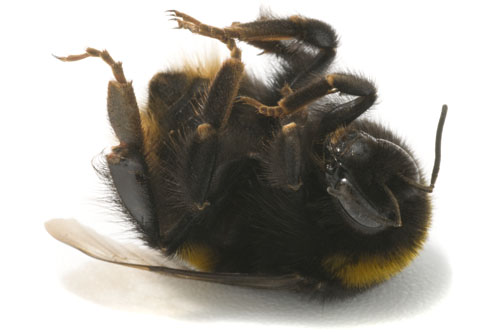03
Apr
Two Studies Link Pesticides to Bee Health, Strengthen Case for Ban
 (Beyond Pesticides, April 3, 2012) Last week, the journal Science published two new studies linking neonicotinoid pesticide exposure to bee health. These two studies, one French, one British, add to a growing body of scientific literature and strengthen the case for removing pesticides toxic to bees from the market. The French study shows that pesticides interfere with honey bee brains, affecting their ability to navigate. The British research finds that pesticides prevent bumble bees from collecting enough food to produce new queens. These studies were released on the heels of an emergency legal petition by beekeepers and environmental groups, including Beyond Pesticides, that calls for the ban of the bee-killing pesticide clothianidin.
(Beyond Pesticides, April 3, 2012) Last week, the journal Science published two new studies linking neonicotinoid pesticide exposure to bee health. These two studies, one French, one British, add to a growing body of scientific literature and strengthen the case for removing pesticides toxic to bees from the market. The French study shows that pesticides interfere with honey bee brains, affecting their ability to navigate. The British research finds that pesticides prevent bumble bees from collecting enough food to produce new queens. These studies were released on the heels of an emergency legal petition by beekeepers and environmental groups, including Beyond Pesticides, that calls for the ban of the bee-killing pesticide clothianidin.
Neonicitinoids are highly toxic to a range of insects, including honey bees and other pollinators. They are taken up by a plant’s vascular system and expressed through pollen, nectar and gutation droplets from which bees forage and drink. They are particularly dangerous because, in addition to being acutely toxic in high doses, they also result in serious sublethal effects when insects are exposed to chronic low doses, as they are through pollen and water droplets laced with the chemical as well as dust that is released into the air when coated seeds are planted. These effects cause significant problems for the health of individual honey bees as well as the overall health of honey bee colonies and they include disruptions in mobility, navigation, feeding behavior, foraging activity, memory and learning, and overall hive activity.
The French study, “A Common Pesticide Decreases Foraging Success and Survival in Honey Bees,” focuses on the neonicotinoid pesticide thiamethoxam, which is metabolized by bees into clothianidin, the pesticide cited in the legal petition. In their study, the researchers used Radio-frequency identification (RFID) to test the hypothesis that a sublethal exposure to a neonicotinoid indirectly increases hive death rate through homing failure in foraging honey bees. When exposed to sublethal doses of thiamethoxam, at levels present in the environment, honey bees were less likely to return to the hive after foraging than control bees that were tracked with RFID, but not intentionally dosed with pesticides. Higher risks are observed when the homing task is more challenging. The survival rate is even lower when exposed bees are placed in foraging areas with which they are less familiar.
The British study, “Neonicotinoid Pesticide Reduces Bumble Bee Colony Growth and Queen Production,” examines the impacts of the pesticide imidacloprid on bumble bee colony health. Researchers exposed colonies of the bumble bees to levels of imidacloprid that are realistic in the natural environment, then allowed them to develop naturally under field conditions. Treated colonies had a significantly reduced growth rate and suffered an 85% reduction in production of new queens compared to unexposed control colonies. The study is particularly noteworthy because it shows that bumble bees, which are wild pollinators, are suffering similar impacts of pesticide exposure to “managed” honey bees. While several studies have linked pesticides to declining honey bee health, wild pollinators have not been intensively studied as their economically-relevant cousins. That said, wild pollinators still provide essential services both in agriculture and to a wide-range of wild plants that could not survive without insect pollination.
On March 21, 2012, commercial beekeepers and environmental organizations filed an emergency legal petition with the U.S. Environmental Protection Agency (EPA) to suspend use of clothianidin, urging the agency to adopt safeguards. The legal petition is supported by over one million citizen petition signatures, targets the pesticide for its harmful impacts on honey bees. The legal petition points to the fact that EPA failed to follow its own regulations. EPA granted a conditional, or temporary, registration to clothianidin in 2003 without a required field study establishing that the pesticide would have no “unreasonable adverse effects” on pollinators. Granting conditional registration was contingent upon the subsequent submission of an acceptable field study, but this requirement has not been met. EPA continues to allow the use of clothianidin nine years after acknowledging that it had an insufficient legal basis for initially allowing its use. Additionally, the product labels on pesticides containing clothianidin are inadequate to prevent excessive damage to non-target organisms, which is a second violation of the requirements for using a pesticide and further warrants removing all such mislabeled pesticides from use.
Learn more about the science, legal petition and what you can do on Beyond Pesticides’ Protecting Pollinators program page.
All unattributed positions and opinions in this piece are those of Beyond Pesticides.










